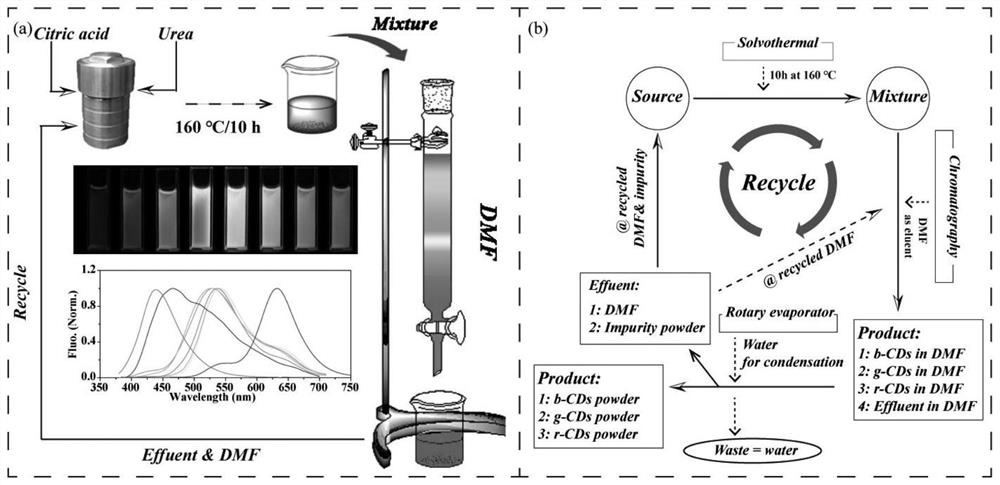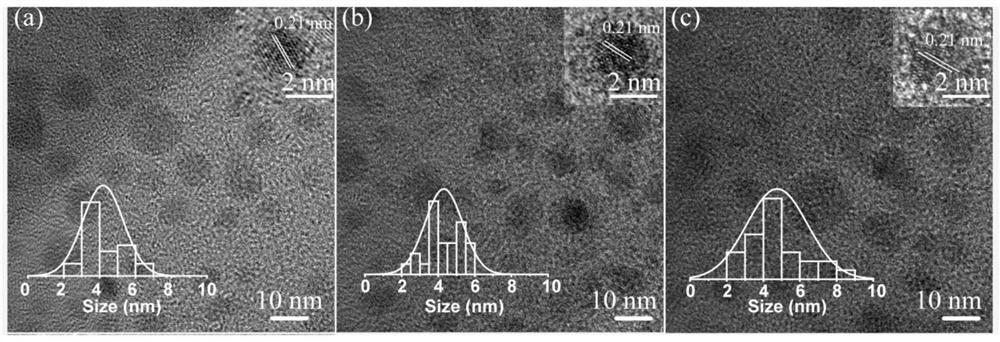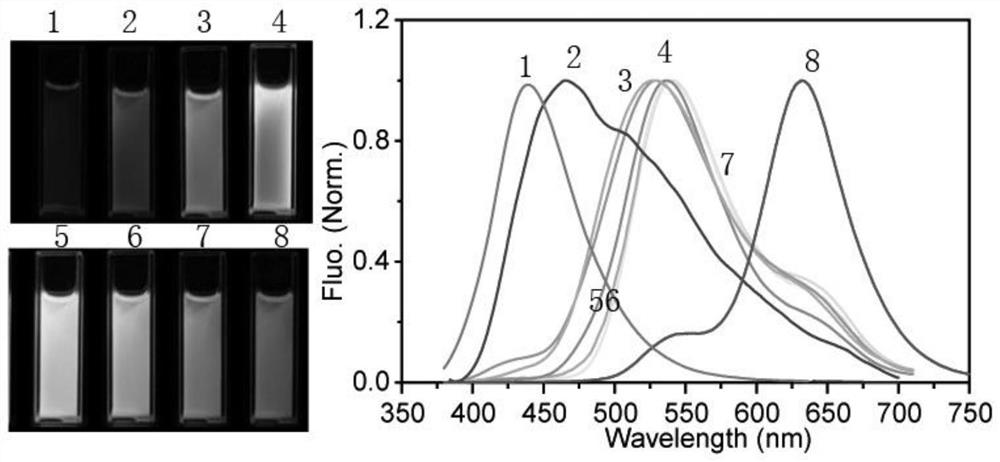Fluorescent carbon dots as well as low-pollution recyclable synthesis method and application thereof
A technology of fluorescent carbon dots and synthesis methods, applied in fluorescence/phosphorescence, chemical instruments and methods, nano-carbon, etc., can solve problems such as waste, limited application, pollution, etc., to reduce pollution, reduce material waste, and achieve high fluorescence quantum yield. rate effect
- Summary
- Abstract
- Description
- Claims
- Application Information
AI Technical Summary
Problems solved by technology
Method used
Image
Examples
Embodiment 1
[0033] This example provides a low-pollution and recyclable synthesis method of fluorescent carbon dots, which is prepared according to the following steps:
[0034] S1. Dissolve 1 g of citric acid and 2 g of urea in 10 ml of nitrogen-nitrogen dimethylformamide, and perform ultrasonic vibration at room temperature to disperse evenly to obtain a mixed solution;
[0035] S2. Place the shaken mixed solution in a hydrothermal reaction kettle, heat it to 160° C. and keep it warm for 8 hours, then cool it down to room temperature naturally;
[0036] S3, the prepared carbon dot solution is dissolved in nitrogen nitrogen dimethyl formamide, using thin layer silica gel (400 mesh) chromatography, the developing solvent is nitrogen nitrogen dimethyl formamide, observed under ultraviolet light, can obtain blue , green, red fluorescent carbon dots and a mixture of fluorescent carbon dots with variegated colors;
[0037] S4, using a rotary evaporator to evaporate the carbon dots with blue,...
Embodiment 2
[0046] This embodiment provides an application of fluorescent carbon dots in the preparation of luminescent thin films.
[0047]Step A. Take enough carbon dot powder prepared in Example 1 and dissolve it in ethanol solution to prepare a carbon dot / ethanol solution with a concentration of 30mg / ml. Ultrasonic vibration is carried out at room temperature to disperse evenly. Take 1ml of carbon dot / ethanol solution and add 9g Epoxy resin glue A, after mixing evenly, add 3g of epoxy resin glue B, and ultrasonically mix evenly to obtain a mixture;
[0048] Step B. Pour the mixture into a mold, put it in a vacuum drying oven, extract the gas and ethanol in the mixed glue, and dry it under vacuum at 80°C to obtain a carbon dot fluorescent film.
[0049] Figure 7 is the photo of the luminescent film based on fluorescent carbon dots under ultraviolet light, by Figure 7 It can be seen that the luminescent films prepared by carbon dots with different fluorescent colors have different f...
Embodiment 3
[0051] This embodiment provides an application of fluorescent carbon dots in biological imaging.
[0052] Step A. Dissolve the carbon dots prepared in Example 1 in phosphate buffer (PBS) to prepare a carbon dot PBS solution with a concentration of 3 mg / ml, and use the carbon dot PBS solution to incubate the cells to prepare cells labeled with carbon dots;
[0053] Step B. Use a confocal microscope to observe the morphological structure of the cells.
[0054] Figure 8 is the biological imaging based on fluorescent carbon dots, where (a) is a bright-field photo, (b) is a single-photon imaging photo, (c) is a two-photon fluorescence photo, (d) is a superimposed photo of one-photon and two-photon imaging, and the scale = 20 µm, by Figure 8 It can be seen that the red carbon dots have good single-photon and two-photon imaging capabilities.
PUM
 Login to View More
Login to View More Abstract
Description
Claims
Application Information
 Login to View More
Login to View More - Generate Ideas
- Intellectual Property
- Life Sciences
- Materials
- Tech Scout
- Unparalleled Data Quality
- Higher Quality Content
- 60% Fewer Hallucinations
Browse by: Latest US Patents, China's latest patents, Technical Efficacy Thesaurus, Application Domain, Technology Topic, Popular Technical Reports.
© 2025 PatSnap. All rights reserved.Legal|Privacy policy|Modern Slavery Act Transparency Statement|Sitemap|About US| Contact US: help@patsnap.com



